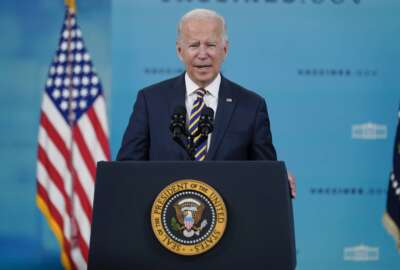In the pandemic, federal, state and local government responses weren’t always aligned
The intergovernmental response to the pandemic is the topic of the latest study from a working group of the National Academy of Public Administration.
Best listening experience is on Chrome, Firefox or Safari. Subscribe to Federal Drive’s daily audio interviews on Apple Podcasts or PodcastOne.
The governmental response to the COVID pandemic pulled in many agencies at the federal, state and local levels. But how well do they work together? The intergovernmental response is the topic of the latest study from a working group of the National Academy of Public Administration. Its main finding, there’s some work to do. The Federal Drive with Tom Temin got more now from working group co-chair and University of San Francisco professor Richard Callahan.
Interview transcript:
Tom Temin: Professor Callahan, good to have you on.
Richard Callahan: Tom, it’s great to be here and thank you for your interest in the intergovernmental dimensions of the COVID-19 response and the consequences.
Tom Temin: And when you look at just the purely federal response, as we have been, that has been complicated enough with “Agencies A” not necessarily agreeing with “Agency B.” When you get into the vertical aspect of government, it sounds like you’ve really got a Rubik’s cube here, a three dimensional issue of interoperability?
Richard Callahan: Well, Tom, I think you describe it well. The horizontal level, working across varied federal agencies, the CDC, NIH, working across the executive branch and congressional branch, that’s challenging enough, but for the field of public health, the state and county and city responses are so important in this that you really do have a strong vertical dimension, and it varies across regions of the country.
Tom Temin: And what did you fundamentally find?
Richard Callahan: I think there’s some overall findings and some very specific findings, the working group, which was self-formed, there was not a specific congressional request – though NAPA is formed as an advisory to offer advice to Congress as a congressionally chartered nonpartisan nonprofit – the key overall findings of the working group and there were 14 members of NAPA and three outside experts who joined us from all over the country, and my co-chair Dr. Ken Kaiser had strong federal experience as former undersecretary of Health for the Veterans [Health] Administration. So we looked at this and the number one finding was that, yes, the intergovernmental dimensions, the intergovernmental system is central to the response. It is not just a federal response, it’s not just a local response, to that there were varied responses across levels of government to ask the question, I do a lot of international work, they’d say, “How is the COVID response going in the United States?” I would say, do you mean at the federal level, or by which state because it varies. The key set of dimensions that the working group focused on were four, and we spent a considerable amount of time on problem identification. And as I said, the working group itself had four or five former state health directors from West Coast, East Coast, all states, current health directors, federal experience, academic experiences, dean’s and four dimensions were identified. One is testing, how to ramp up and get started, what are the lessons learned there, and the advice that can be offered. Two were nonpharmaceutical interventions as a whole dimension and particularly, we would know that as social distancing and masking. Three, the vaccine distribution, and then four, there were a set of overarching issues on data collection, supply chain, and finance. And so there were, as you use the phrase, this Rubik’s cube of this matrix of responses, not only did you have the vertical dimension, but you had across at least these four major areas. And then the fourth overall finding was that there were a set of actionable recommendations that we could have for helping improve performance for protecting lives and protecting all lives, making sure that no one’s left behind, that there was really an emphasis on health equity. So they would be the four key overarching findings.
Tom Temin: I guess it seems, looking at this report, one of the overarching questions might be, who does properly respond when a health issue like this bursts out very suddenly, and people are looking at television and the White House press conferences, when in fact, the administration of this is always through the local entities? And some even nonprofits, even some drugstore chain got into this. So is it ultimately a governance question or just a structural, “ability to get along and everyone play together” question?
Richard Callahan: Well, Tom, your question is the question: How do we respond? And there’s so many elements in that the “we” piece is huge and what do we mean, by the “we?” It is both the local working with the state and the federal, the various federal agencies working together, working across sectors. The nonprofits I know in California, where I’m based, the nonprofit responses I think of Sierra Health Foundation and others, particularly for outreach for vaccine distribution to all communities is really essential. So I think one of the key pieces to recognize at the beginning is, it is not just a whole of government effort. It’s a whole of society effort to respond to an epidemic and prevent it from becoming a pandemic.
Tom Temin: We’re speaking with Richard Callahan. He’s a professor at the University of San Francisco, and co-chair of the NAPA Working Group on the intergovernmental dimension of the COVID pandemic response. Your main recommendations then are what? What can we do better the next time and should there be some kind of a playbook for pandemic response? Maybe we’ve had them in the past, and they somehow get shelved and forgotten about?
Richard Callahan: The idea of a playbook is essential in emergency response. The saying over the years that I’ve heard always in emergency responses, if you’re at the Incident Command System, and you’re exchanging business cards there for the first time, it’s too late. So the preparation piece is very significant. The playbook piece, the journalist Michael Lewis covers it quite well, in his book “The Premonition” about there were people and there were efforts at the federal level to develop a playbook and advance. The fast-changing nature of this really calls for the type of response and the multi-dimensional response at this working group found calls for, in answering your question, a recognition from the starting point, that there’s not a response, that there is a set of responses across a set of agencies, and that intrinsic to it is the intergovernmental dimensions. What I’ve come to understand that NAPA is really the intergovernmental system is how we problem solve in our society outside of national defense, and even to a certain extent within that. So the recognition that all partners at the very start and the full mobilization, like the recommendation for testing, to use national lab systems, and really look at this as what can be done to develop the partnerships that are needed, and the partnership piece being the operative word. And, one of the striking features and working with this working group is how much talent there is in public health in response, and whether it’s in state health systems and federal agencies, or in the academic and research communities. There’s a lot of talent. And really, it’s a mobilization of all that talent across a lot of different dimensions.
Tom Temin: And looking in hindsight at this whole process for a couple of years, it seems like the communications were often garbled among the many entities, again, across the federal government and then vertically. And I don’t like to use the word messaging because that has a phony, “let’s tell them what we think they ought to hear” type of quality to it. But I mean, real communication, honestly, with what’s going on, to the point where the average person of the public didn’t really know what was going on.
Richard Callahan: Well, the communication piece is significant in any governmental response. The challenge that we face, and it’s a challenge that NAPA is particularly strong at addressing, which is really how do you address what NAPA calls the grand challenges of government? And another way of looking at the recommendations of this group are they’re not only actionable, but they’re recommendations to get at the key to any piece of communication, which is, how do you build credibility? How do you build trust in a system, and particularly where there’s a fast-moving challenge in a pandemic? And so, looking at each of the recommendations, whether it’s really helping establish an early warning system, all of them help get at? How do you effectively communicate that we’re working together to protect lives, we’re working together to protect all lives across all dimensions of American society. And that’s a complicated piece of work. And here’s what we know, at this time and here’s what we can do. And I think the other question that you raised very thoughtfully is this question of how do we take the lessons learned, and there’s a number of different types of reports. This report at NAPA focuses on the intergovernmental dimensions, but really one of the key features that research and what we know from our experience is, how do we learn from this specific case, and incorporate it into recommendations for the future? So NAPA is part of that effort, and there’s more that can be done there?
Tom Temin: And just looking at the summaries of the recommendations, you seem to lay the top responsibility at the federal level? I’m looking at just going down through them Health and Human Services should – HHS should – OSHA should, CDC should, and so on, so on, so on. All the “shoulds” are for the federal level, for something that schmears all over the entire country like COVID?
Richard Callahan: Well, there is that level of it. And I agree with you. And if you look at recommendation 1.5 and 1.7, it’s very clearly the recommendations are in collaboration with state and local public health departments in collaboration with. And so while there’s an identification of Health and Human Services, or CDC, there’s also a very important recognition that these efforts are really, again, it’s the recommendation from the vaccination campaign, local jurisdictions should lead efforts to reach communities at greatest risk. So I think what you find here is that emphasis on partnership, that working with the people who are closest to the challenge and local public health agencies and state public health agencies, and also facilitating what federal agencies can do very well.
Tom Temin: And finally, considering the ringer that everybody has been through for these past couple three years, we now have not so much a response question as a knowledge management issue before us.
Richard Callahan: I would add to that, and it’s one of the great findings and research on the private sector and Jim Collins’ [book] “Good to Great” on candor, and learning from past experience, like, can you confront the – candidly have discussion? And there’s other research on organizational performance. But it is, can you talk through these lessons and can you apply them moving forward? The NAPA fellow Don Kettl has a brilliant article on Hurricane Katrina and the lessons learned from that. And so there’s a lot of discussions. You see the Pulitzer Prize-winning work of Ed Yong at the Atlantic. There’s a lot of information developed inside government, inside nonpartisan think tanks, nonpartisan research like you have at NAPA and other places. How do we bring those together? What’s worked? What were pieces that work? There was a brilliant member of, who talked about what worked on the emergency response ESF #8, what worked and what can be improved. And that’s one of the concluding remarks is really how do we prepare for the next epidemic?
Tom Temin: Well, definitely worth a read. Richard Callahan is professor at the University of San Francisco and co-chair of the NAPA Working Group on the intergovernmental dimensions of the COVID pandemic response. Thanks so much for joining me.
Richard Callahan: Tom, I’d like to thank you. I’d like to thank Terry Gerton, the president and CEO of NAPA, the director of the Center for Intergovernmental Partnership Nancy Augustine, my co-chair Ken Kaiser, and each of the working group members and thank you for your very thoughtful questions.
Copyright © 2024 Federal News Network. All rights reserved. This website is not intended for users located within the European Economic Area.
Tom Temin is host of the Federal Drive and has been providing insight on federal technology and management issues for more than 30 years.
Follow @tteminWFED






